

|
Dead Horse Point is connected to the plateau by a narrow neck, 30 yards wide,
with cliffs falling away 2,000 feet on each side. One story goes that
cowboys once drove a herd of wild mustangs onto the point and then
fenced them there with branches and bushes across the neck. They
chose the horses they wanted and, for unknown reasons, left the fence
in place. The remaining horses died of thirst with the Colorado
River in view 2,000 feet below, and that was the origin of the name.
The panorama above shows some of the view from the point. The brown-colored Colorado River, bordered by green trees, is visible at several locations. This is desert up here at 6,000 feet. The pinyon pine and Utah juniper provide very little shade. Canyonlands National Park is located on the same plateau, several miles to the southwest. Arches National Park is lower in elevation, about 15 miles to the northeast as the raven flies. Ravens were our buddies. They were talkative, social, and almost always around. Our only conflict with them was that they wanted to eat our garbage and we wanted to keep them from littering the park. Lizards, cottontail rabbits, violet-green swallows, and black-throated sparrows are also common in the park, and we even saw a few kit foxes. Once again, we volunteered at a state park in order to spend time in an area we wanted to learn about. And, as we did in Washington state last year, we worked as camp hosts. |

|
We chose Dead Horse Point State Park in Utah because a friend said it was “awesome” and because the average temperatures for June and July were below those for Idaho’s Bruneau Dunes State Park, where we were in 2013. Well, June this year was unseasonably hot! It was a dry heat, but hot is hot. Then on the 4th of July we had a spectacular all-night thunderstorm. The rest of July was a bearable, dry heat. By the way, out there even the rain is often dry. The word for rain that evaporates before reaching the ground is “virga”. The scenery is awesome!
Our travel was delayed by two weeks due to problems getting our Moving House repaired from problems that arose in 2012 and from our accident last summer. But eventually the repair shop was able to get the needed parts from the manufacturer and was even able to solve our refrigerator problems as well (by replacing the old one). We missed a chance to spend a few days at Zion and we were a week and a half late getting to our jobs at the park in Utah. A lot worse things could have happened.
|
Dead Horse Point seen from Canyonlands National Park,
4 1/2 miles southwest. The La Sal mountains are distantly visible. |
Dead Horse Point seen from the Colorado River |
|---|---|
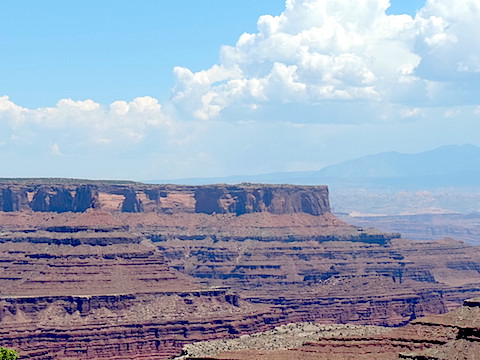
|
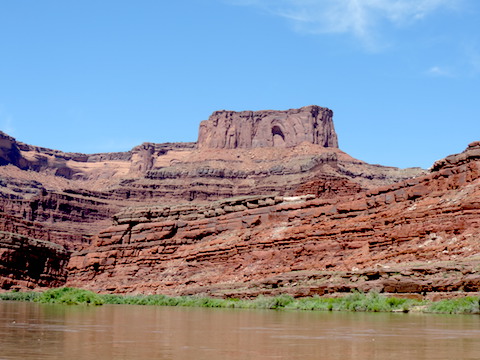
|
|
Gail on the trail on the west rim of the park |
Us at the Neck, Canyonlands in the background |
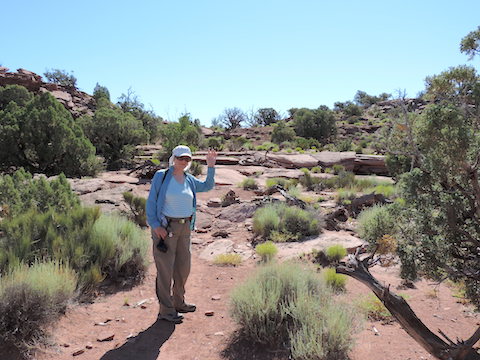
|
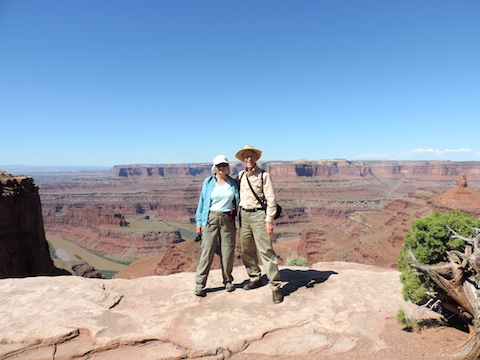
|
|
Al with the ruins of two small, 1,000-year old Native American granaries near Aztec Mesa in Canyonlands National Park |
Prickly pear cactus blossom |
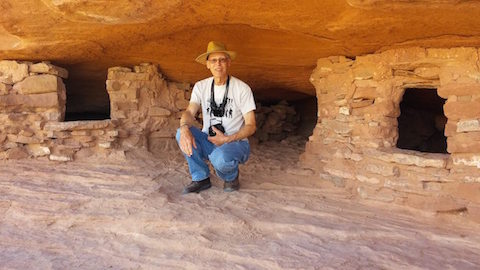
|
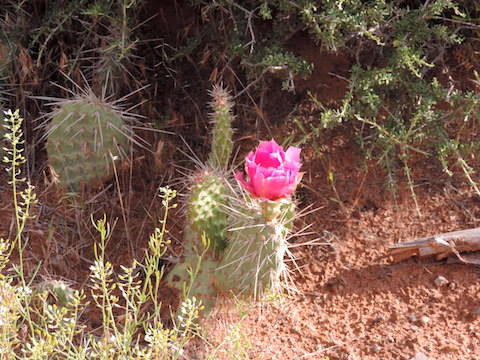
|
|
A kit fox stared at us from its den |
Compacting trash in the dumpster to foil the ravens |
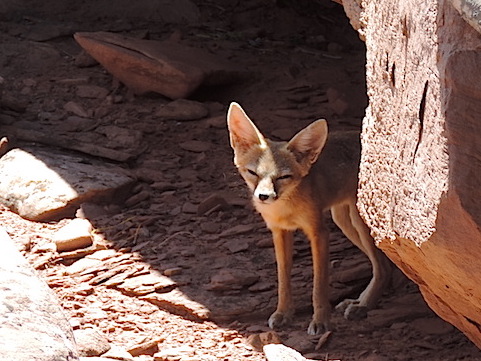
|
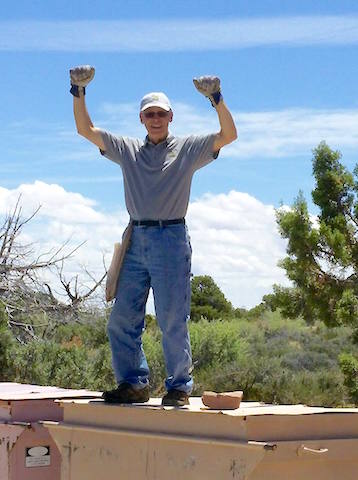
|
The remnants of a 60-million year old meteor crater or something else? Eugene Shoemaker and a colleague found evidence that this Upheaval Dome at Canyonland National Park was caused by an ancient meteor strike; other geologists think a buried salt dome caused it.

|
At Warner Lake in the La Sal Mountains east of Moab. At 9,200 feet, much more comfortable than in Moab |
At Landscape Arch in Arches National Park |
|---|---|
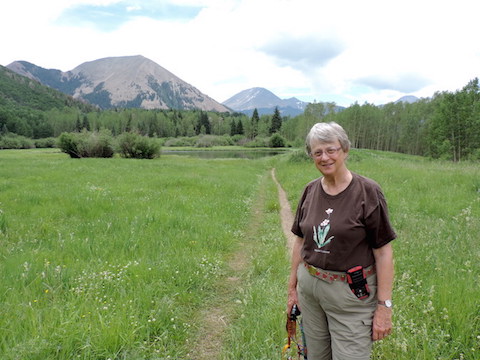
|

|
Moab is a center for outdoor adventure: whitewater rafting, mountain biking, off-road vehicle driving, wilderness camping, etc. Our own adventures mostly involved hiking along desert trails. In the Fiery Furnace section of Arches National Park we did follow a ranger, jumping gaps and bracing hands and feet on one rock wall with our backs against another to slide along a crevice. And we took an all-day white-water rafting trip on the Colorado River through Westwater Canyon near the Colorado state border.
|
In Westwater Canyon. The black stone is the same Visnu Shist formation as at the bottom of the Grand Canyon |
Scene from our rafting trip through Westwater Canyon |
|---|---|
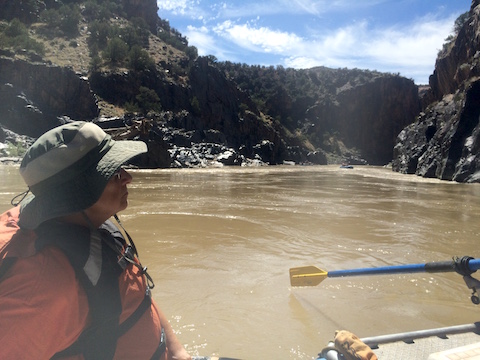
|
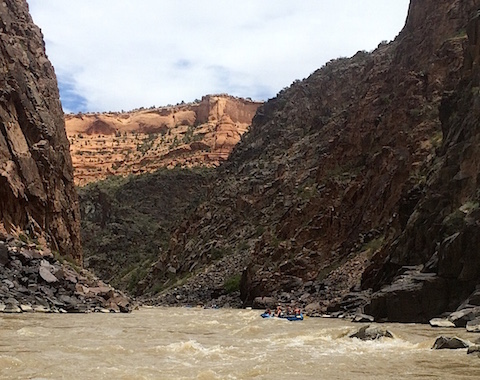
|
|
Without a ranger to guide us, we would have been lost in the many narrow canyons and tall fins of the Fiery Furnace |
Mountain biker (not one of us) in Dead Horse Point State Park |
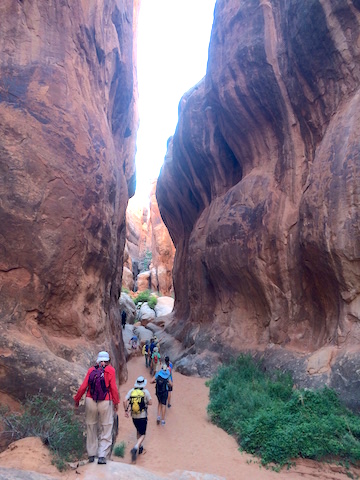
|
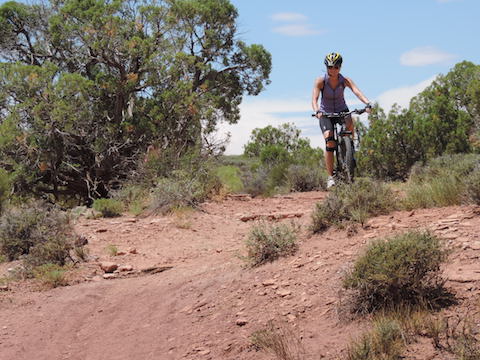
|
|
Gail points to one sauropod footprint in a trail at Copper Ridge, maybe made by a camarasaurus 150 million years ago |
A three-toed theropod footprint at Copper Ridge, possibly made by an allosaurus. Car keys give the scale of the fossil. |
|---|---|
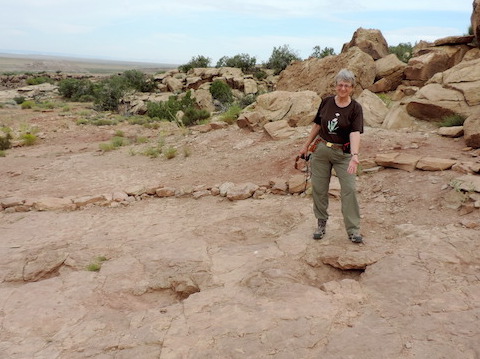
|
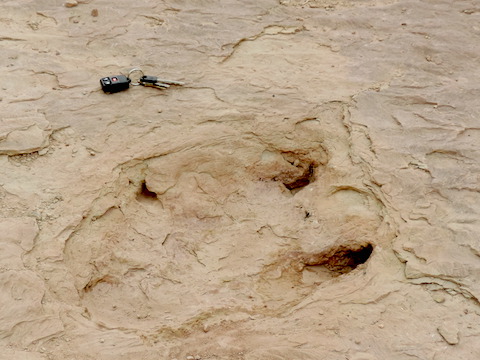
|
|
Puzzling images left on the shore of the Colorado River during the Archaic cultural period 6,000 BCE to 1,000 BCE |
Newspaper Rock bears images spanning over 2,000 years. Navajo call it “Rock That Tells A Story”, but no one now knows what the story is |

|
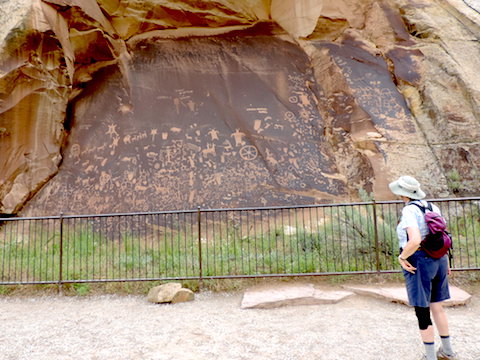
|
|
Detail from Newspaper Rock |
More detail from Newspaper Rock |
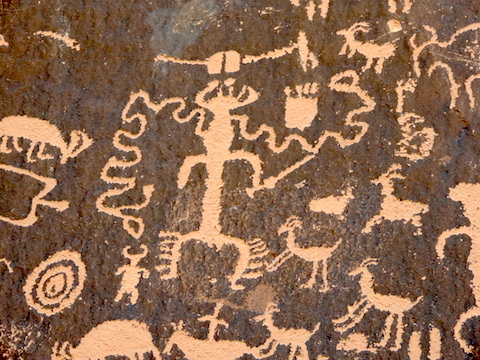
|
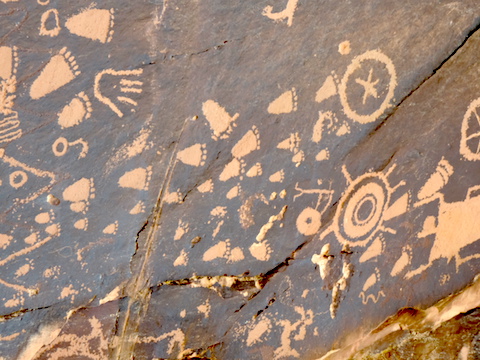
|
|
Ruins of a food storage structure built on the banks of the Colorado by Fremont Culture people about 1,000 years ago |
Ranch house lived in by the Wolfe family about 100 years ago. Now in Arches National Park. |
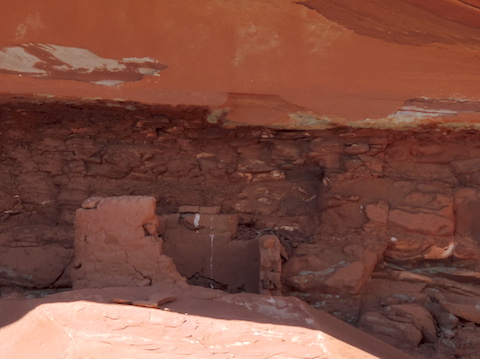
|

|
|
This region is also rich in movie history.
John Ford started it by filming the movie
Wagon Master near the Colorado
River a little northeast of Moab. He returned the next year with John Wayne to
film Rio Grande.
Since then many westerns
have been filmed here in whole or
in part. A few are Cheyenne Autumn, City Slickers II: The Search for Curly's Gold,
and the recent The Lone Ranger.
Some of the many non-westerns filmed here are The Greatest Story Ever Told, Indiana
Jones and the Last Crusade, Galaxy Quest, and Mission Impossible II.
In the center of this photo is Fossil Point, located between the Colorado River and Shafer Trail Road, as seen from Dead Horse Point. This is where Thelma and Louise took their final plunge, not at the Grand Canyon. Check out http://www.discovermoab.com/movie.htm for more about movies made near Moab, including at Dead Horse Point State Park. |
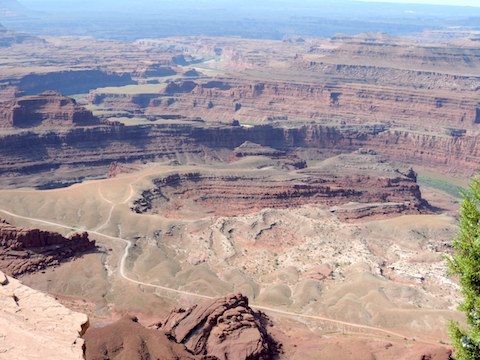
|
|
Cliff Palace, one of the most famous dwellings |
At Long House, we got to crawl into rooms |
|---|---|
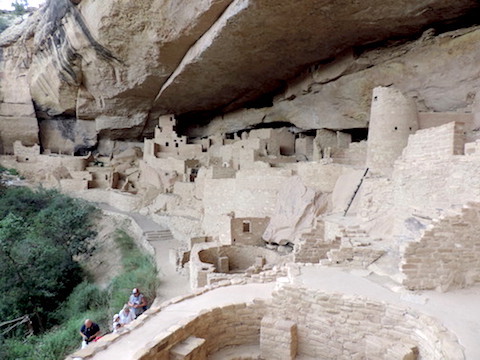
|

|
Mesa Verde also has petroglyphs The line illustrates a journey by Native American clans. |
A ruined, unreconstructed tower on a point across the canyon from the petroglyph site. |
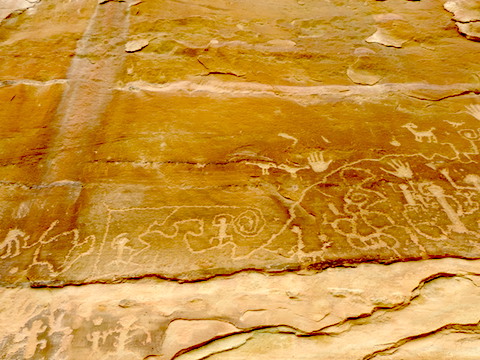
|

|
|
Gail and Ed at Chasm Falls along the Old Fall River Road |
A pika near the Alpine Visitor Center. Cute little guys. |
|---|---|
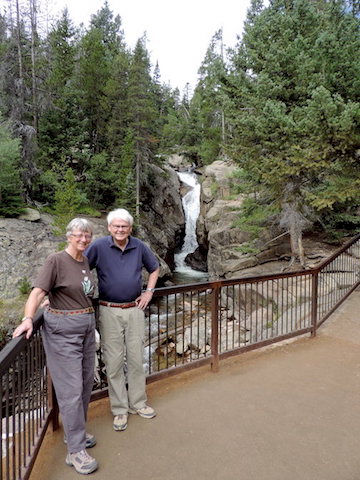
|
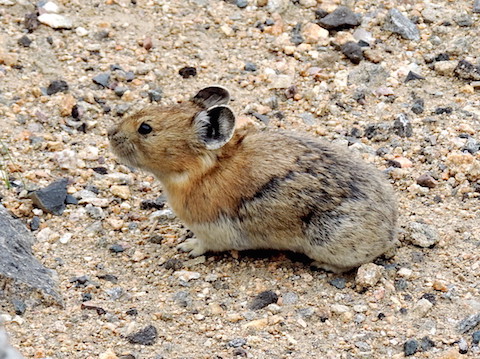
|
|
At Bear Lake, on our way to Emerald Lake |
At Ouzel Falls |
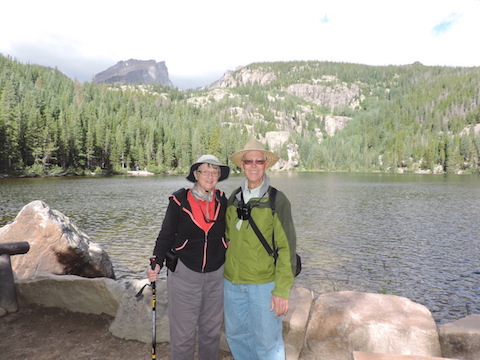
|

|
In Minnesota we visited with Gail's brother and his family and with Bill & Julie. Bill was Gail's supervisor when she worked at the University of Minnesota. Al gave a version of his presentation on Fire or Ice: The Ends of our Earth at Coffman Condos. One highlight of our time in Minnesota, was that Al was contacted by “new” relatives, 3rd cousins living in Minnesota and one was able to attend Al's presentation.
|
Gail's brother, Guy, and Gail after dinner at The Bungalow |
Al with his new-found cousin, Mike |
|---|---|
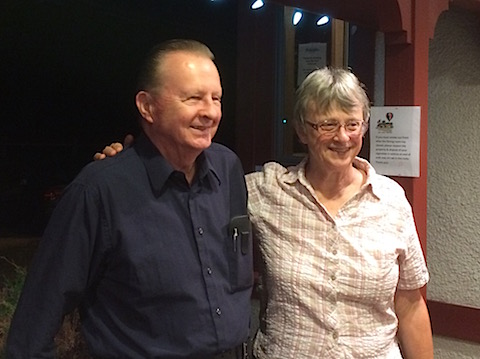
|
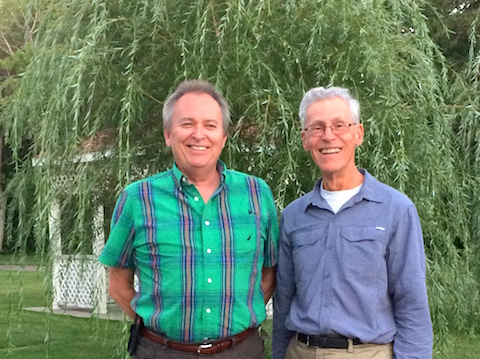
|
|
|
|
|
We crossed the border to Ontario (don't bring eggs
when you cross) to take part in a reunion of cousins
descended from five Swedish brothers and sisters, most of whom arrived in
Canada early in the 20th century. (Our Minnesota cousins
are descended from the uncles of that generation.)
We met in Kenora on beautiful Lake of the Woods for an
active two days.
Sadly, due to injury and other health issues, not all the cousins were able to participate as much as we wanted to see them. This photo shows some of our group standing on the steps of Kenora’s city hall. When our grandparents lived here, this building housed the post office and our grandparents surely climbed these steps many times.
When returning from Canada to the U.S., produce you've purchased
in Canada may be confiscated by the U.S. border guards. The apples and
bell pepper were gone, but we were allowed to re-import the lettuce,
produced in the U.S.A. and sealed in plastic.
We stopped at the Porcupine Mountains Wilderness State Park in Michigan for just one day. We should spend more time there in the future. |
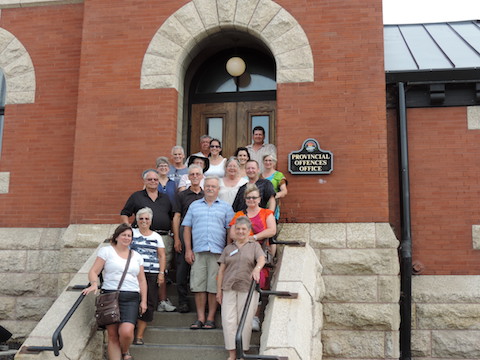
|
|
At Manabezho Falls on Presque Isle River in the Porcupine Mountains |
Lake Superior at Porcupine Mountains in the evening |
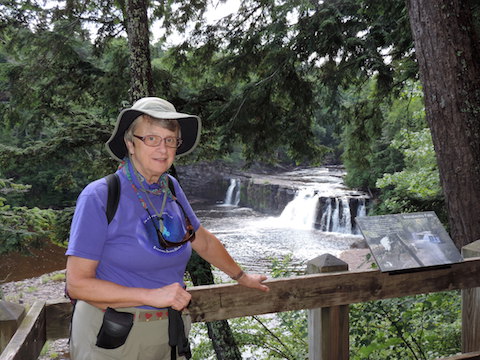
|

|
The next stop was our annual get together with the Minn Clan, a group of former co-workers from the University of Minnesota. This year we assembled in Calumet, Michigan, on Michigan's Keweenaw Peninsula and site of a famous 1913 catastrophe, when someone falsely shouted “fire” in a hall crowded with the children of striking copper miners. This area is also renowned for lake-effect snow. One winter they had over 390 inches of snow, almost twice as much as Buffalo, New York's, record.
|
Gail and Julie searching the beach of Gitche Gumee for agates |
When looking for agates, Lolly found a fossil |
|---|---|
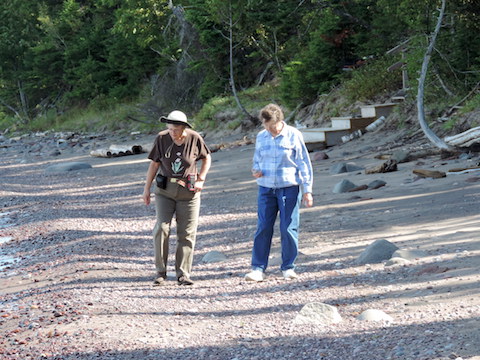
|
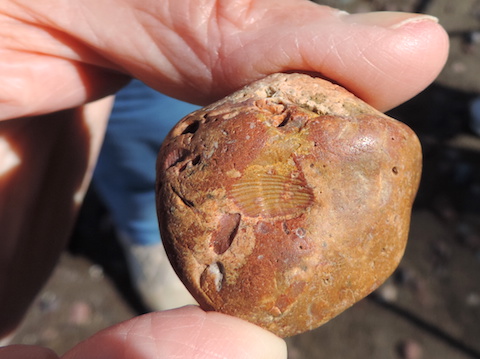
|
|
Wood Duck near the Apple Blossom Trail |
|
|---|---|
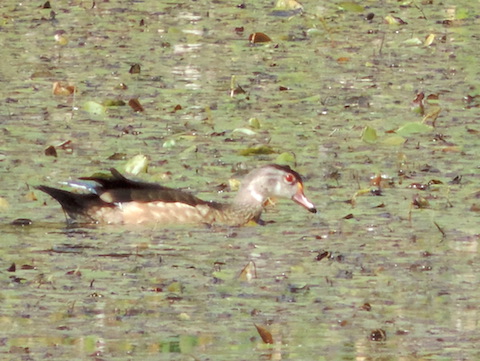
|
We spent a whole week in Iron County, Michigan, trying to relax but still keeping
busy. Al gave his Ends of the Earth talk at the
Iron
County Historical Museum.
We attended the End of Summer Blues Fest in the tiny village of Alpha.
It featured good local artists like the
Flat Broke Blues Band.
We ate the unique pizza of the
Riverside Pizzeria twice,
once with Al's brother and sister-in-law, and once with Gail's schoolmate,
Sherry, and her husband, Val, Al's schoolmate.
This brings us to a couple of “It’s A Small World” stories. Al and Gail grew up about 250 miles apart, in Iron River, a small town in Michigan near the border with Wisconsin and in Genoa City, a smaller town on Wisconsin’s border with Illinois. They met and married. Unlikely as it might seem, theirs was not the only marriage between these two towns. Sherry, a schoolmate of Gail's, married Val, a schoolmate of Al's. Improbable? Well, just listen to the next one. Al attended college in California and lived in a student house with 17 classmates. One classmate, Ken, was from California. Ken's cousin married a sister of Margee, Al's grade school and high school classmate. We all were in Iron River this August. |
| Gail and Maija with one of the painted cows in New Glarus, Wisconsin | |
|---|---|
|
Our last stops were Madison, Wisconsin, and
Indiana Dunes National Lakeshore.
From our base in Madison, we visited New Glarus, home of a Heidi festival and the New Glarus Brewery. We also visited Ten Chimneys, the farm estate of Alfred Lunt and Lynn Fontanne, great stage actors from the 1920s through the 1950s. We toured the remodeled Department of Astronomy and talked with Jay Gallagher and Jeff Percival, formerly grad students while we were there, now staff members at the University. We had a four-hour lunch with Edith, daughter of the former Astronomy Department secretary, and friends Gil and Alana. Our scheduling system (namely Al) made a mistake by planning our visit to Indiana Dunes during the Labor Day holiday weekend. The lakeshore was crowded with beach goers from Chicago. The first two days we were in Madison were hot and humid, though it did get better later. And the day we were at Indiana Dunes was hot and humid. We longed for the drier and cooler days of the west and north. |
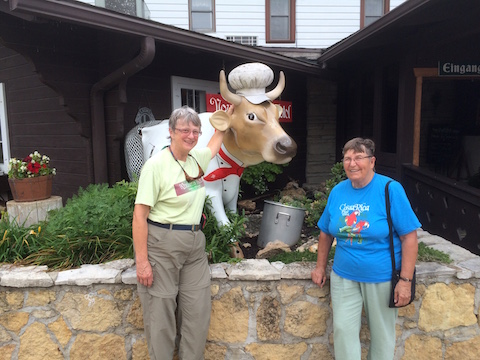
|
|
Trying on a prop at Ten Chimneys
|
About to climb one of the dunes at Indiana Dunes, easy compared with the trails in the Rocky Mountains |

|
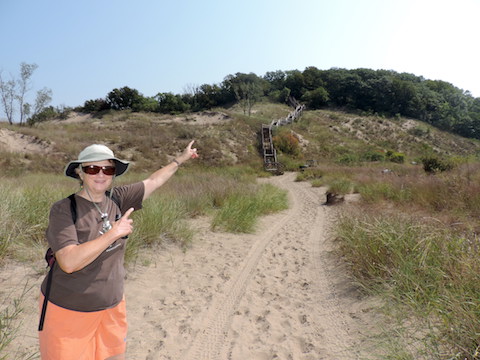
|
Here are a few more scenes from our summer.
| Black-throated sparrow | Looking through Mesa Arch in Canyonlands | Dwarf evening primrose |
|---|---|---|
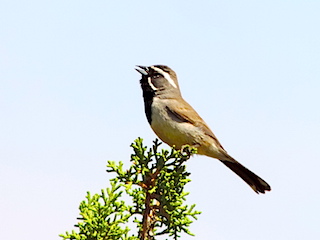
|
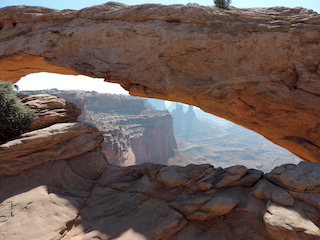
|
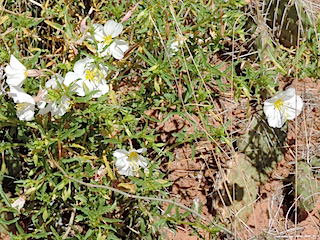
|
|
The trail to Mesa Verde's petroglyphs |
Northern whiptail lizard |
Three ravens in conference |
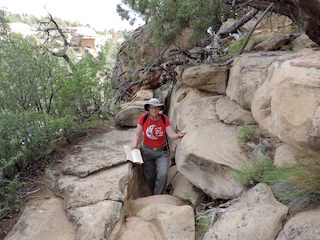
|

|
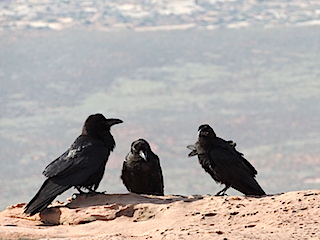
|
|
Cushion Buckwheat Flower along the trail to Aztec Butte |
One of many crossings in Negro Bill Canyon (renamed Grandstaff Canyon in Oct 2017) |
Violet-green swallow in Arches |

|
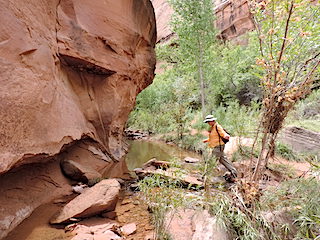
|

|
|
Canyon & White Rim seen from Grand View |
Whale Rock at sunset |
Descending from the summit of Whale Rock |
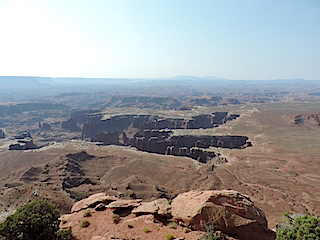
|
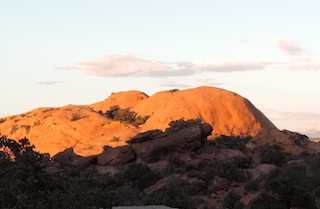
|
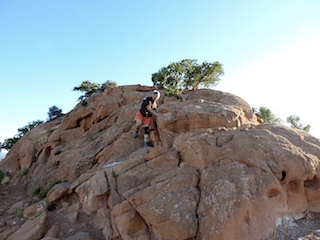
|
|
Emerald Lake, 10,080 feet high in Rocky Mountain National Park |
The measure of the Keweenaw Peninsula's 390 inches of snow |
A superior Lake Superior sunset
|
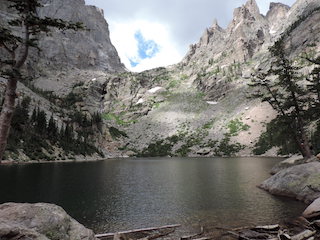
|

|

|